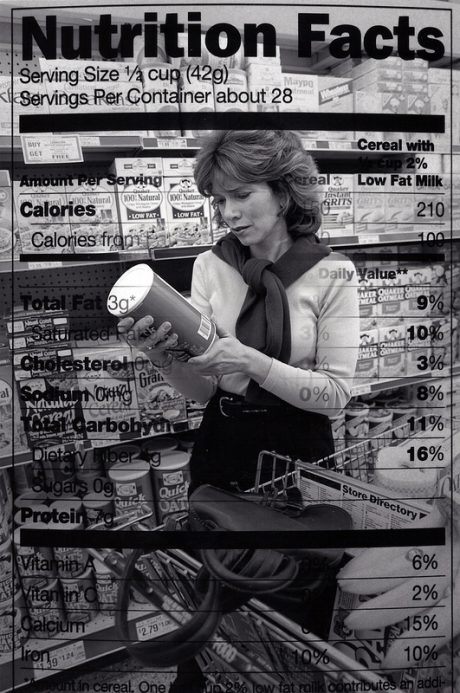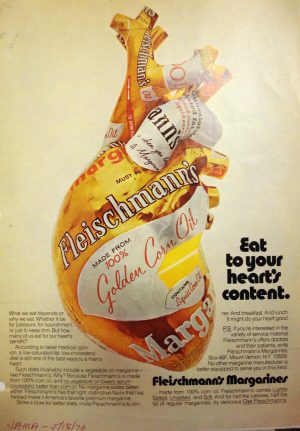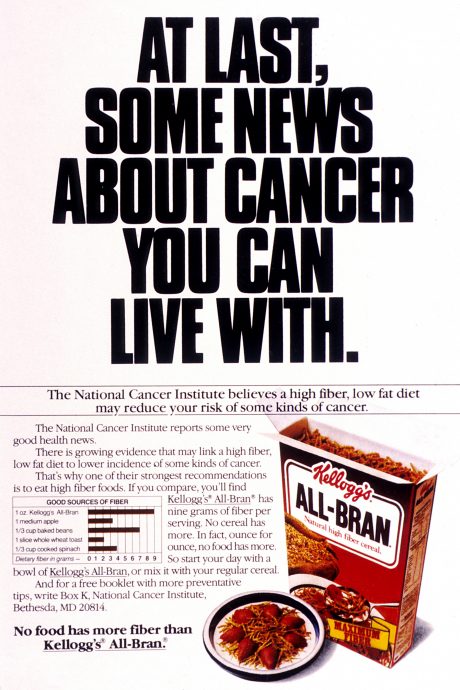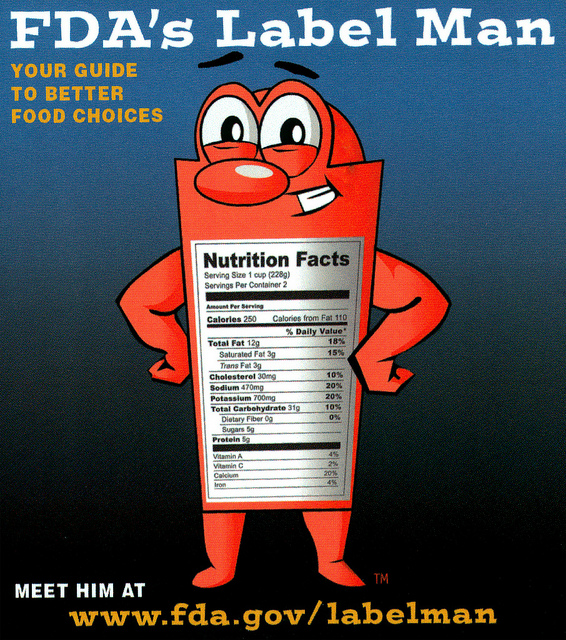 Strolling down the grocery store aisle, the consumer is awash in a sea of product information. Boxes, bags, and cans made of cardboard, plastic, or metal (with paper label wrap) are stained with a rainbow of color, intended to grab the attention of the passers-by; friendly, stately, or even slick company logos neatly frame bold, two-inch-tall letters spelling out in a commanding—though hopefully familiar—voice the brand of the food product. Littered across the “Principal Display Panel,” to use the US Food and Drug Administration’s (FDA) lexicon for the front of a package, are colorful (implied) health claims about the food’s appealing qualities—“All Natural,” “ORGANIC,” “100% REAL,” or “Clinically PROVEN to Help Reduce Cholesterol,”—which sit alongside more conventional marketplace puffery: “ORIGINAL” or “AMERICA’S FAVORITE.” Along the side or back, there is an extended zone of food information: summaries of the company’s romanticized history, instructions on how to prepare the food, further recipes that use it as an ingredient, or strategies to incorporate the product into a daily balanced diet.
Strolling down the grocery store aisle, the consumer is awash in a sea of product information. Boxes, bags, and cans made of cardboard, plastic, or metal (with paper label wrap) are stained with a rainbow of color, intended to grab the attention of the passers-by; friendly, stately, or even slick company logos neatly frame bold, two-inch-tall letters spelling out in a commanding—though hopefully familiar—voice the brand of the food product. Littered across the “Principal Display Panel,” to use the US Food and Drug Administration’s (FDA) lexicon for the front of a package, are colorful (implied) health claims about the food’s appealing qualities—“All Natural,” “ORGANIC,” “100% REAL,” or “Clinically PROVEN to Help Reduce Cholesterol,”—which sit alongside more conventional marketplace puffery: “ORIGINAL” or “AMERICA’S FAVORITE.” Along the side or back, there is an extended zone of food information: summaries of the company’s romanticized history, instructions on how to prepare the food, further recipes that use it as an ingredient, or strategies to incorporate the product into a daily balanced diet.
It is here that the consumer discovers the conspicuously inconspicuous information panel, a black box modestly titled (in bolded, flat two-dimensional lettering and easy-to-read Helvetica) “Nutrition Facts.”[1] Strikingly austere in its white-on-black eighth-grade-math-chart display format and ninth-grade-health-101 vocabulary, the Nutrition Facts panel almost leaps out at the consumer by its contrast with the more colorful, flamboyant product information displayed elsewhere on the package.
Over the course of the twentieth century, regulators, advertisers, public health advocates, doctors, scientists, and food manufactures have together created an “information infrastructure” that attempts to give information consistency and meaning. Labels are a technology of trust, not a simple source of competence: rather than a one-dimensional “everything is information” approach, it makes more sense to understand them as engaging a hierarchy of values shaped by public and private work that reflects changing understandings of governance, regulation, and individual responsibility.
Studies on improving labels usually look at whether people read them correctly; they focus on either comprehension (is the information legible to the reader?) or priorities (does/should the information on the label matter to the reader?). But this focus on the individual misses the more dynamic marketplace for food labeling where normative and descriptive claims blur, where information has an aesthetic value and attention is the prime commodity, and where there is an interplay between the freedom of “commercial speech” (buyer beware!) and the legal, physical, and above all linguistic constraints of what one can meaningfully convey in so few words about a food. Thinking about labels as infrastructure leads us to different questions: how do changes in labels restructure the marketplaces in which they are embedded? How do they change food itself?
The FDA’s “Nutrition Facts” panel, introduced in the 1970s and revised in the 1990s, is a good example of how regulators and businesses use labels to shape what Richard Thaler and Cass Sunstein so provocatively—and for my purposes conveniently—call the “choice architecture” of informational markets (2008). The FDA Nutrition Facts panel represents a more fundamental change in the regulation and structuring of food markets than simply helping consumers make health choices. The introduction of the Nutrition Facts panel emerged from a half-century debate over how to rationalize food markets through product classification, including how foods would be distinguished from drugs or medicines.
Treating or Eating?
In the twentieth century, food labels and packaging rules were a key tactic in assuring product safety and quality in the market, forming an “architecture of authority” (Silbey and Ewing 2003). Two forms of authority were relevant: the FDA’s interest in using labels as a tool for market accountability, and physicians’ associations’ concern with consolidating doctors’ authority on matters of health. The 1938 Food, Drug and Cosmetic Act had given the FDA authority to seize or ban mislabeled products, but left ambiguous where the label—and the possible misinformation on it—started and stopped. The FDA could take action based on what was stated on the “label,” the food law term for the physical label attached to food packaging, but over the course of the 1940s and 1950s a series of court cases extended FDA authority by expanding the legal term “labeling” to any and all informational materials that reference the label and/or bear upon its interpretation. Food labeling would therefore include advertising campaigns or health claims that might not appear directly on the food package, and even informational health pamphlets (though not books) that might be sold along with a dietary supplement. The product label thus sits at the center of a legally constructed terrain of intertextual or hypertextual references.
One of the FDA’s main goals was the removal of ineffective or harmful products marketed as drugs or having drug-like powers. The 1938 Act passed as a result of public outrage over deaths caused by an adulterated drug product, Elixir Sulfanilamide, and one of the FDA’s most common uses of the new law was to remove misbranded “food” products that made or implied health claims. For instance, FDA regulators developed the “jelly bean rule,” which prohibited the sale of any candy-like product that included vitamins to promote a medical product to a popular market. One consequence of this system was that the FDA restricted the amount of information that would appear on food labels, limiting the labels to a standard identity, whereas drug labels or “special dietary foods” might have extensive ingredient panels or instructional information.

A heart wrapped in Margarine labels. From the Journal of the American Medical Association, 1970.
A key partner in the FDA’s efforts was the American Medical Association (AMA), which had long been concerned with medical quackery and patent drugs. In the 1960s, the AMA worked with the FDA to develop a clearer prescription drug system with more detailed drug informational labeling, intended to aid and standardize physician practice. Raising the standards of quality in drug markets went hand in hand with campaigns to discredit alternative markets as medical and nutritional quackery. The AMA and FDA together would launch the “Campaign Against Nutrition Quackery” in the late 1950s and early 1960s to combat what one FDA Commissioner called “the nutritional ‘big lie’—that the American food supply is impoverished and nutritionally deficient” (Larrick 1961).
“Food or drug,” for the FDA and AMA, was not simply a decision about labeling, but about where that product would appear in the marketplace and who could sell it. Borderline products created headaches for regulators because they might appear at the drugstore, targeted to patients under counsel of a physician, but they also might appear in supermarkets next to the ordinary equivalent product. The introduction of Sweet’N Low, for example, brought artificial sweeteners to a whole new demographic of consumers because of its packaging in a sachet rather than pill or tablet, suggesting that it could be used not only as a supplement but also as a food additive. Under this regulatory regime, the AMA and FDA imagined a world where healthy individuals didn’t need special information and could purchase food labeled as food, whereas patients could seek advice on health directly from doctors.
Despite the FDA and AMA’s campaigns against nutrition and medical “quackery” and attempts to articulate clear rules separating special medical products from ordinary foods, people continued to buy special dietary products from alternative health markets, and advertisers continued to skirt the line between food and drugs when marketing health information about non-medical foods. By the early 1960s, the FDA was overwhelmed by the popular consumption of artificially sweetened sodas, concern over the “cholesterol scare,” interest in low-fat diets, and the continued rise in vitamin-enriched foods and supplements. During this period one can find an odd alignment of right- and left-wing antiestablishment critiques of the FDA’s food–drug labeling system as an intrusion by the government into personal choices. California Governor Ronald Reagan cited proposed FDA dietary regulations in 1968 as yet another example of how the FDA was destroying the freedom of industry to run its own affairs. “If I feel better taking a little vitamin C to ward off a cold,” Reagan declared, “government can keep its sticky labels off my pill bottles” (Food Chemical News 1968:34). Michael Jacobson, founder of the Center for Science in the Public Interest, would write in 1972 about the problematic existence of what he called “silent labels” that “list none or only a few of the ingredients and additives that the food contains” (Jacobson 1972). The widely celebrated mantra of the consumer’s “right to know,” drawn from Kennedy’s consumer’s “bill of rights” at the start of the decade, was taken up on both sides to push for informational labeling. The informed consumer was no longer imagined as sick or healthy, but as moving within a continuum of healthfulness (Dumit 2012). Nutrition labeling now placed the responsibility for health on informed, active consumers managing their own lifestyles.
From Safety to Responsibility
In 1973, the FDA introduced new rules that dramatically changed its food labeling policies. It required a “nutrition information” label on any foods that made an explicit or implied health claim, and it chose to allow more vitamin-enrichment of ordinary foods without necessarily classifying them as special dietary foods. These changes allowed the industry to innovate and experiment without relying on the agency to endorse the results by setting standards. More significant, for the FDA, the change meant that it would now be regulating nutrient and ingredient information profiles as much or more than the standards for foods themselves.

The health benefits of ALL-Bran, and the endorsement of the NIH.
As a result, in the 1970s there was an explosion of new diet foods labeled low in saturated fats or sodium, but also an explosion of explicit and implied health claims not officially permitted under the new system. A high-ranking government official, speaking of this period, would declare, “The grocery store has become the tower of Babel, and consumers need to be linguists, scientists, and mind readers to understand many of the labels they see” (Lyons & Rumore 1993: 249).Kellogg’s All-Bran cereal was a prime example of these changes: it carried a statement, endorsed by the National Institutes of Health’s (NIH) National Cancer Institute, that fiber had health properties shown to be associated with a reduction in incidences of colon cancer. Because Kellogg’s got the NIH’s permission, the FDA’s hands were tied on declaring the product misbranded. Companies facing prosecution quickly used the All-Bran case as precedent for allowing their own disease claims. The National Cancer Institute campaign illustrates the growing popularity of public–private collaborations at this time, but it also illustrates the value of labels as a private–public infrastructure. The NIH was as eager as Kellogg’s to get its campaign message onto the cereal box because doing so would spread its public health message well beyond the Institute’s more conventional educational reach.
In the early 1990s the FDA overhauled the nutrition label, introducing the current “Nutrition Facts” panel. This label had several new features, including the percentage of recommended daily values, the calibration of amounts to standard serving sizes, and an average diet set at 2,000 calories a day. Now all foods, not just diet foods, would carry the label. Also important, however, was how the label fit into an entire infrastructure of health information. Any health claim or statement on a food on the front panel would have to direct readers to the label on the side or back panel. The idea was that this would help solve the problems with the food–drug divide by centralizing the flow of diet information in the market, situating the FDA as the main arbiter of what was sound scientific advice on diet and nutrition.
However, industry lobbyists now criticized the FDA label as an infringement on “freedom of commercial speech,” echoing Reagan’s criticisms two decades before. One representative of the industry lobbyist group Council for Responsible Nutrition stated its concern in a 1993 television interview:
…the FDA has a very narrow interpretation of the information they believe can be allowed to consumers. We believe that the Congress’s intent [in the 1990 Nutrition Labeling and Education Act] was that there should be a free flow of information to allow consumers to know what the value of the product was. FDA has taken several years now, and it’s literally choked off the flow of information to consumers, and we think that needs to be opened up (Taylor and Cordaro 1993).
Faced with these criticisms, FDA Commissioner David Kessler hedged his characterization of the label as liberating the consumer but containing apolitical information. In a 1994 television interview with Larry King, Kessler repeated the FDA line that “It’s information for consumers [but] it’s up to people what they do with it,” to which King responded: “You’d have to be whack to be mad at information” (Kessler 1994). The new politics of nutrition labeling was no longer framed around healthy or sick, or “authentic” versus novel, but around whose responsibility it would be to sift through the information overload in the supermarket: big institutions or the individual? In the words of a CBS news report on the Nutrition Facts panel: “The new food label is designed to make experts out of everyone.”
Is the Medium the Message?
The focus on personal choice misses how some choices in “choice architecture” happen before the end consumer receives it. Nutrition labeling changed not only the information available about food, but the foods themselves. It resulted in a market restructuring away from standards of “food qua food” to food as information and components (ingredients and nutrients), which led companies to reformulate their food recipes to create better nutritional or ingredient profiles. This change in the food precedes the consumer-reader at the supermarket, yet directly affects what is eaten; it is an example of how mass foods are regularly redesigned within this information infrastructure.
Infrastructure is often a solution to problems of scale, where official standards are designed to coordinate complicated, heterogeneous markets. Infrastructure like the Nutrition Facts label is designed to be optimal for mass markets. Small changes on the label can work across big markets. This was why the FDA built its regulatory authority around the legal apparatus of “labeling” and surveilling informational, virtual markets rather than direct product seizures and bans. It also means that the message of nutrition labeling is not personal, but rather acts at a collective level, often with synergistic, nonlinear effects. Burkey Belser, the president of the firm hired to design the 1990s Nutrition Facts panel, noted, “Something that you see over and over and over and over again, across all media or all packaging and the like, gradually…seeps itself into the mind so that you start to…understand it and absorb it in ways that supersede reading” (Belser, personal communication, October 14, 2009). When infrastructure functions well, it is discreet and invisible; this can make it even more powerful in shaping behaviors. Very few actually read the Nutrition Facts label anymore, and yet most regularly talk about and think about food’s nutrients. Indeed, one does not need to read—or even think—about the label for it to play a part in his or her everyday life.
